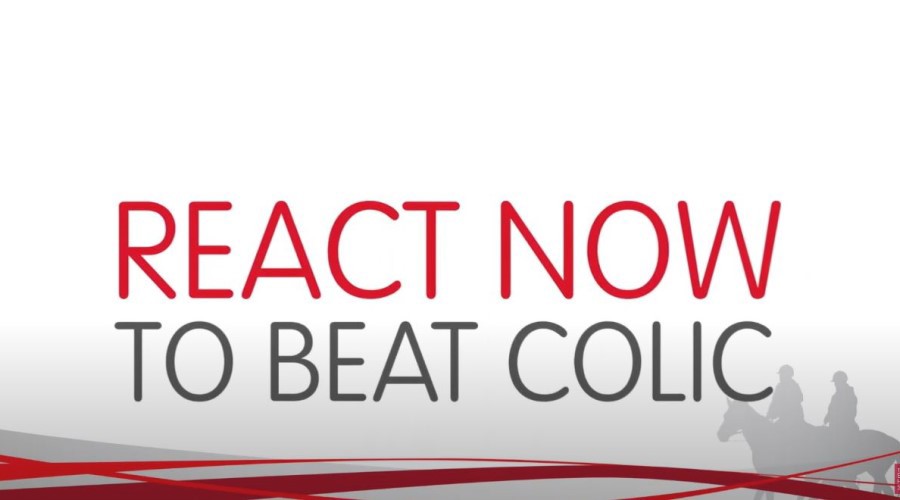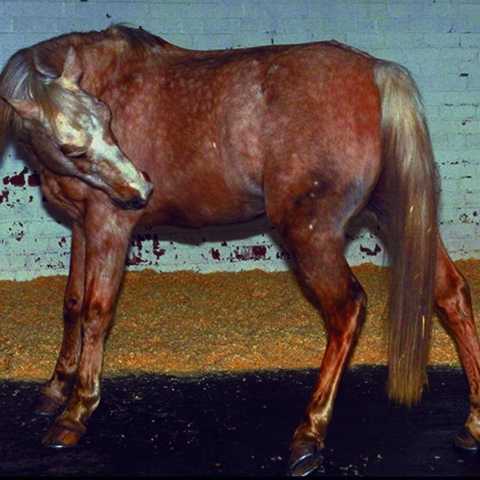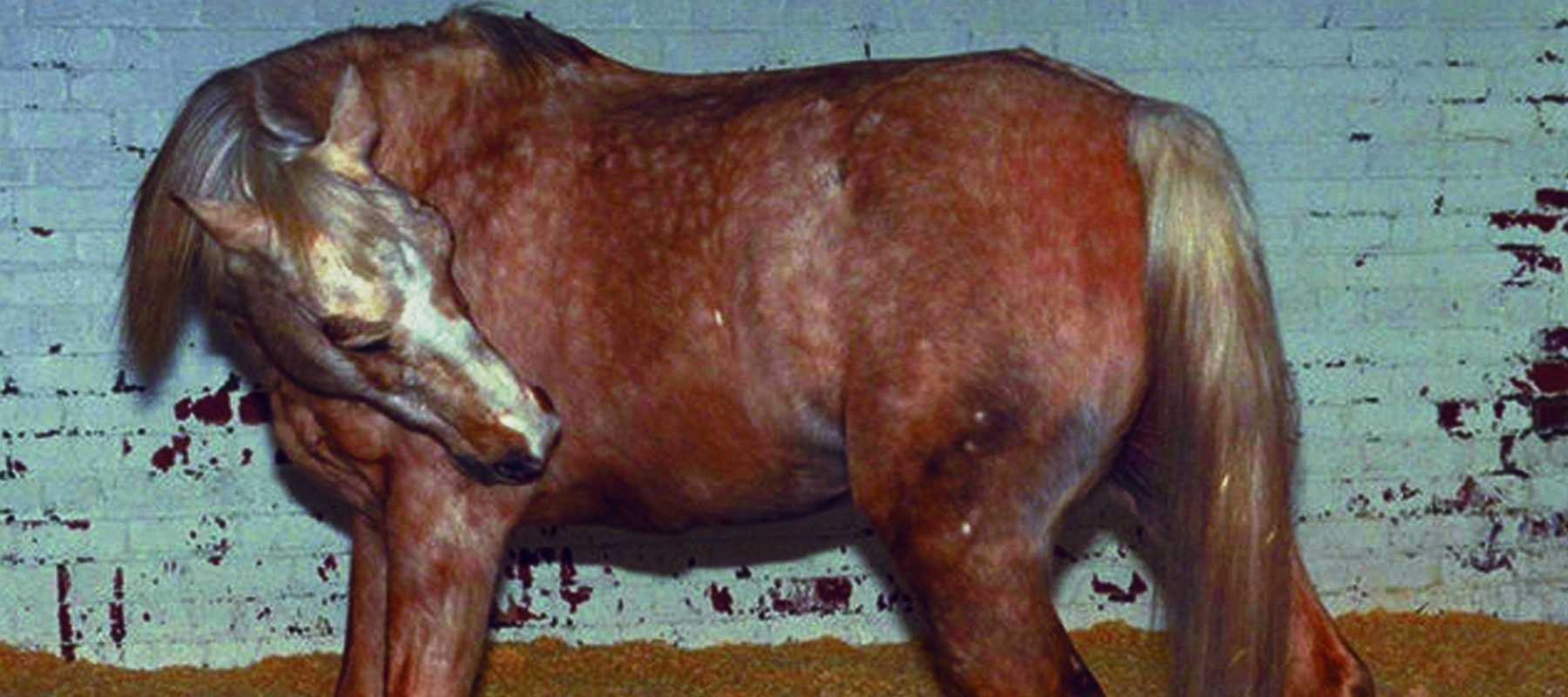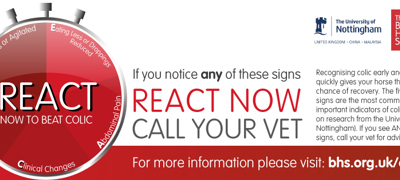In conjunction with

Colic is the most common equine emergency and cause of death in horses worldwide. The different types of colic come under six broad categories; Spasmodic, Tympanic (flatulent or gas colic), Impaction, Sand colic, Displacements, and Strangulations.
The information below discusses the wide range of issues related to colic and has been produced from the evidence, recommendations and involvement of veterinary surgeons, horse owners and original research conducted by The University of Nottingham.
Signs
Horse owners, or the main person responsible for the care of horses, play a vital role in recognising the early signs of colic. Colic cases can quickly deteriorate so early recognition and prompt veterinary attention is vital to increase the chance of recovery for the horse.
The five REACT signs are the most common and important indicators of colic. The signs include:
Restless or agitated
chevron-down
chevron-up
- Attempts to lie down
- Repeatedly rolling
- Unexplained sweating
- Box-walking or circling
Eating less or droppings reduced
chevron-down
chevron-up
- Eating less or nothing at all
- Passing fewer or no droppings
- Changes in consistency of droppings
Abdominal Pain
chevron-down
chevron-up
- Flank watching
- Pawing
- Kicking at belly
Clinical Changes
chevron-down
chevron-up
- Increased heart rate
- Reduced or absent gut sounds
- Changes in colour of gums (healthy gums should be a salmon pink colour)
- Rapid breathing rate
- Skin abrasions over the eyes (indicates that the horse has been thrashing around and has caught this prominent area on their face; for example on the walls of the stable)
Tired or Lethargic
chevron-down
chevron-up
- Lying down more than usual
- Lowered head position
- Dull and depressed
Reducing the risk of colic
Colic can occur at any time of the year in both grass-kept and stabled horses. Due to the many potential risk factors for colic there are many simple steps that can be taken to help reduce the risk of it occurring.
 play-circle
play-circle
Watch
Knowing your horse’s vital signs
Knowing the ‘normal’ temperature, pulse and respiration (TPR) rates for your horse means you’ll be able to recognise when these values are abnormal. If there is no reason for a change in TPR due to factors such as recent stress or exercise, seek veterinary advice.
What will my vet do if my horse has colic?
Your vet will go through a series of steps when they examine your horse to help rule out more serious problems and attempt to establish the most likely reasons your horse is showing signs of pain.
Rectal examination
chevron-down
chevron-up
Rectal examination is the test that vets use most often to help them find the cause of colic. Rectal examination involves the vet placing their hand and arm into the horse’s rectum so that they can feel inside the abdomen. This enables them to identify anything that feels abnormal or out of place, and in many cases, it is an important part of deciding what next steps and treatments are required.
Nasogastric intubation
chevron-down
chevron-up
Nasogastric intubation, more commonly known as stomach tubing, involves passing a hollow tube up the horse’s nose, down the oesophagus (gullet) into the horse’s stomach. It is used by a vet to identify if there are any abnormal contents in the horse’s stomach, and to administer fluids and some treatments directly into the stomach. It is the second most used test to help diagnose horses with colic.
What happens at a referral?
Referral to an equine hospital for a horse or pony suffering from colic may be considered for a number of different reasons, including:
- The need to undertake more detailed clinical evaluation that may not be possible at home
- Provide constant observation
- Referral for possible surgery
- Be able to provide intensive medical treatment e.g. intravenous fluid therapy or repeated administration of fluids by nasogastric tube
Emergency decision making
Time is of the essence when a horse has colic, especially if the case is severe and referral to a veterinary hospital is required. Any delay could potentially affect the outcome for the horse. It can be helpful to prepare an emergency care plan in advance to avoid making rushed decisions.
Downloadable Resources
WARNING: SOME LEAFLETS CONTAIN SURGICAL PHOTOS
- What is colic?
- Recognising the signs of colic
- Reducing the risk of colic
- Emergency decision making
- Normal temperature, pulse and respiration parameters in adult horses
- Waiting for the vet to arrive
- What will my vet do if my horse has colic?
- Rectal examination
- Nasogastric intubation
- What happens at referral?
- How to help your horse - a quick guide
- Poster and emergency numbers
Further information
Acknowledgements
The British Horse Society and The University of Nottingham thank all those involved with the production of the colic information. The leaflets have been written and reviewed by:
- Professor Sarah Freeman, Dr John Burford, Dr Adelle Bowden and Professor Gary England School of Veterinary Medicine and Science, The University of Nottingham
- Professor Tim Mair – Bell Equine Clinic
- Professor Debbie Archer – University of Liverpool
- The British Horse Society Horse Care & Welfare Team
Get in touch – we’re here to help
The Horse Care and Welfare Team are here to help and can offer you further advice with any questions you may have. Contact us on 02476 840517* or email welfare@bhs.org.uk – You can also get in touch with us via our social media channels.
Opening times are 8:35am - 5pm from Monday – Thursday and 8:35am - 3pm on Friday.
*Calls may be recorded for monitoring purposes.




